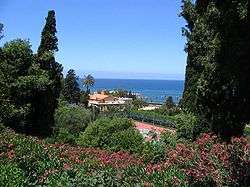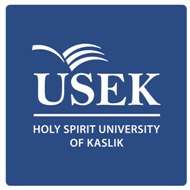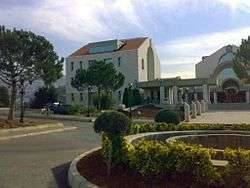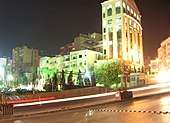Education in Lebanon
Education in Lebanon is regulated by the Ministry of Education and Higher Education (MEHE). In Lebanon, English or French with Arabic are taught from early years in schools. English or French are the mandatory medium of instruction for mathematics and science for all schools.[1] Education is compulsory from age 6 to age 14.[2]
According to a 2013 World Economic Forum report, Lebanon was ranked 10th in overall quality of education, and 5th in science and math.[3] However, these rankings are based on the Executive Opinion Survey, in which business leaders of each country give their opinion on the educational system in their own country. This survey is carried out as part of the WEF's Global Competitiveness Report. According to Muhammad Faour, a nonresident senior associate at the Carnegie Middle East Center in Beirut, "this assessment is a significant departure from the results of student achievement tests in every international test Lebanon and Qatar have participated in."[4]
On the biggest ever global school rankings, conducted by the OECD's economic think tank and compiled from an amalgamation of international assessments, including the OECD's Pisa tests, the TIMSS tests run by US-based academics and TERCE tests in Latin America, Lebanon ranked 58th globally in maths and sciences. [5][6] In the international student achievement tests in math and sciences (TIMSS) in 2007 and 2011 for grade 8, Lebanese students scored well below the international average of 500. In math, Lebanon scored 449 in both 2007 and 2011.[4]
Lebanon's adult literacy rate is 93.9% in 2014(http://hdr.undp.org/en/countries/profiles/LBN), according to the UN Human Development Index, ranking it 65th globally.
The percentage of the population as a whole with at least some secondary education (aged 25 and above) is 54.2%. For the percentage of the female population with at least some secondary education, the figure drops to 38.8%.[7]
Education system
Education in Lebanon is divided into 5 cycles split in 3 phases: Pre-school education, basic education, and secondary education, the latter ending on a Baccalaureat or a "professional certificate", which both give access to tertiary education.[8] Education is compulsory age 6 to age 14, being the basic education cycle.[2] Pre-school education (cycle 1) starts at age 3 or 4. Basic education is then composed of two levels: elementary level and intermediate level. Elementary level is grade 1 to 3 (cycle 2) grades 4 to 6 (cycle 3). Intermediate level is grades 7 to 9 (cycle 4). Secondary Education is grades 10 to 12 (cycle 5). Secondary Education is usually completed at age 18.[8]
It is worth noting that an estimated two-thirds of Lebanese students attend private schools. In April 2015, the Minister of Education, Elias Bou Saab, acknowledged the myriad challenges and gaps that exist in the Lebanese school system, in particular in the public schools. While Lebanese law stipulates that the national curriculum should be updated every four years, it has not been updated since 2000. In addition, because of national disagreement over Lebanon's modern history, the history textbooks in particular only cover history until 1943. The national exams (Grade 9 Brevet and Grade 12 Baccalaureate) were not marked in 2014. [9]
Pre-school education
According to the World Bank database, gross enrollment rate of pre-school education is 62.5 percent for male, 68.3 percent for female, and 64.4 percent for total in 2006.[10] Pre-school education aims to initiate children into the school environment. The goal of pre-school education is 1) to create a favorable climate for the children to communicate with others, 2) to develop their physical capacities, limb control and coordination of their movements, and 3) to educate their senses. Pre-school education also takes into account physiological moral and intellectual development of children.[11] According to the World Bank database, private enrollment share for pre-school education is 80.3 percent in 2008.[10]
Basic education
Elementary Level
According to the Worlds database, gross enrollment rate of elementary level of basic education is for 96.8 percent for male, 93.9 percent for female, and 95.4 percent for total in 2007. Private enrollment share in elementary level is 67.6 percent in 2007.[10]
Intermediate level
Primary completion rate of Lebanon (US$6,000 GNI per capita in 2007) is lower than that of Tunisia, Jordan, Iran, Algeria, West Bank and Egypt (all of which have lower GNI per capita). Primary completion rates have not improved during the period 1995/96 to 2003/04.[12] In 2007, Primary completion rate is 79.8 percent for male, 83.3 percent for female, and 81.5 percent for total.[10] According to UIS database, technical and vocational enrollment as percent of total enrollment in intermediate level is 5.1 percent in 2008.[11] Private enrollment share of general education in intermediate level is 60.2 percent and that of technical and vocational education is 56.8 percent in 2008.[11]
Secondary education
Secondary education is three years education, the first year is common for all students, and the second year is either scientific or literature whereas the third year composes of (humanities, economics, life sciences, general sciences) and technical education (about 55 different fields of study). Most schools, however have deviated from this system. They usually do not offer Humanities education, citing socio-economics as a better and more efficient alternative School principals decide students’ path based on students’ aptitude as shown by the first secondary and second secondary years. When students complete three years education, they take official Lebanese Baccalaureate exams in their respective tracks (four in all). Students who finish examinations successfully obtain the Lebanese Baccalaureate Certificate of Secondary Education (Shahaadat Al-Bakaalouriya al Lubnaaniya l’il-ta ‘liim al-Thaanawi) or the Technical Baccalaureate (Al-Bakaalouriya al-Finniya)[13] In 2014, the Minister of Education passed all students who took the exam, regardless of their score.[14]
According to the United Nations Human Development Index, the gross enrollment rate for secondary school is 74%.[7]
Palestinian refugees in Lebanon have limited access to public secondary education. Most of them are not able to afford the high cost of private secondary education. UNRWA operates three secondary schools in Beirut, Saida and Tyre. School operated by UNRWA partially offset the absence of available educational opportunities at the secondary school level. (UNRWA website) According to the World Bank database, gross enrollment rate of secondary education is 69.8 percent for male, 80.2 percent for female, and 74.9 percent for total.[10] According to UIS database, technical and vocational enrollment as percent of total enrollment in secondary level is 27.8 percent in 2008.[11] Private enrollment share of general education in intermediate level is 49.8 percent and that of technical and vocational education is 56.9 percent in 2008.[11]
Lebanon participated in TIMSS in 2003 and 2007. Score of mathematics at 8th grade is 433 in 2003 and 449 in 2007.[15] Score of science at 8th grade is 435 in 2003 and 404 in 2007.[16] At the end of middle school, each student has to enter the official exams.
Tertiary education
Tertiary education in Lebanon is composed of Technical and Vocational Institutes, University colleges, University Institutes and Universities. The Lebanese University is the only public institution. The Ministry of Education and Higher Education administrates the private and public sectors and Technical and Vocational Institutes are under the Directorate General of Technical and Vocational Education Directorate General of Higher Education has responsibility for University Colleges, University Institutes and Universities).[13]
According to the World Bank database, gross enrollment rate of tertiary education (the percentage of students who go on to tertiary education within five years of completing secondary education) was 48% in 2013.[17]
With university graduates making up 30% of people seeking a job,[18] it is clear that the Higher Education system needs to play a key role in resolving the problem of youth unemployment in Lebanon. The key issue related to this sector is the mismatch between the highly skilled graduates that universities supply and the skills and professionals the labor market demands; these supply-demand failings in the labor market are increasingly preventing young people from finding a job in their country that fits their qualifications.[19] In order to address these issues, universities can implement policies to: 1. Reform the curricula to better prepare graduates for their professional life 2. Improve career guidance structures and activities 3. Invest in relevant research, statistics and data gathering.
Lebanon has 41 nationally accredited universities, several of which are internationally recognized.[20][21] The American University of Beirut (AUB) and the Université Saint-Joseph (USJ) were the first Anglophone and the first Francophone universities to open in Lebanon respectively.[22][23] The majority of the forty-one universities, both public and private, largely operate in French or English, the two most widely used foreign languages in Lebanon.[24]
At the English universities, students who have graduated from an American-style high school program enter at the freshman level to earn their baccalaureate equivalence from the Lebanese Ministry of Higher Education. This qualifies them to continue studying at the higher levels. Such students are required to have already taken the SAT I and the SAT II (Subjects Test) upon applying to college, in lieu of the official exams. On the other hand, students who have graduated from a school that follows the Lebanese educational system are directly admitted to the sophomore year. These students are still required to take the SAT I, but not the SAT II.
The highest-ranked universities in Lebanon include the American University of Beirut (AUB), the Lebanese American University (LAU), the Université Saint-Joseph (USJ), the Lebanese University (LU), the University of Balamand (UOB), the Université Saint-Esprit de Kaslik (USEK), Beirut Arab University (BAU), the American University of Science and Technology (AUST), the Lebanese international university (LIU) , and the Notre Dame University - Louaize (NDU),[25][26] QS Top Universities ranks AUB second in the Arab region (the only Lebanese university to rank among the region's top 10), and 268 globally.[26][27] The THE (Times Higher Education) World University Rankings 2015-2016 place the American University of Beirut between 501 and 600 in its rankings, while the Center for World University Rankings places AUB at 682 in its global rankings; AUB is the only Lebanese university to make either of these lists. [28][29]
Not all private higher educational institutions in Lebanon consider SAT I or SAT II for undergraduate admissions. The majority require a local entrance test prepared by these individual higher educational institutions. In most times, the entrance test is a placement test. The main requirement for undergraduate admissions for Lebanese students is the secondary-school leaving certificate called the Baccalaureate II or more recently the International Baccalaureate. However, students with a foreign nationality are admitted to private higher education institutions that pattern after the American system of higher education as Freshman students in case they do not have an equivalence to the Baccalaureate II. In case they obtain an equivalence from the Ministry of Education and higher Education, they are admitted as sophomore students. As for the Lebanese University, which is the only public higher educational institution in Lebanon, students are admitted to undergraduate programs based on their Baccalaureate II. A number of Faculties at the Lebanese University, such as the Faculty of Sciences require further testing for selectivity based on entrance tests (concours) prepared and administered by this faculty.
 AUB established in 1866 by the American Board of Commissioners for Foreign Missions.
AUB established in 1866 by the American Board of Commissioners for Foreign Missions. Saint Joseph University, or Université Saint-Joseph, founded by the Jesuits in 1875.
Saint Joseph University, or Université Saint-Joseph, founded by the Jesuits in 1875. Holy Spirit University of Kaslik, or Université Saint-Esprit de Kaslik, founded by the Lebanese Maronite Order (LMO) in 1938.
Holy Spirit University of Kaslik, or Université Saint-Esprit de Kaslik, founded by the Lebanese Maronite Order (LMO) in 1938. NDU, founded by the Maronite Order of The Holy Virgin Mary in 1978.
NDU, founded by the Maronite Order of The Holy Virgin Mary in 1978. American University of Science and Technology, founded in Achrafieh in 1989.
American University of Science and Technology, founded in Achrafieh in 1989.
Education management
Ministry of Education and Higher Education (MOEHE) regulates all education institutes in the public sector through a regional education system. The education system in Lebanon is centralized, and this regulation is not direct. The education system is managed through regional education bureaus. Public schools are monitored by the regional education bureaus in the governorates. The regional education bureau serves as liaisons between the public school and the directorates of education at the ministry's headquarters. Private schools have their own organization, but private schools are still subject to the authority of the MOEHE.[30]
The Center for Educational Research and Development (CERD) is an autonomous staff organization under the trusteeship of the MOEHE. CERD's tasks are 1) to draft curricula of academic and vocational education for the pre-university education stage, 2) to revise and modify the curricula according to the necessity, 3) to prepare all means and ways for applying these curricula, 4) to do educational research, 5) to secure training for pre-university teachers, 6) to prepare the curricula in all subject areas, 7) to provide teacher training, 8) to write textbooks, and 9) to conduct evaluations, etc.[30]
Education finance
According to the United Nations Human Development Index 2014, public education expenditure as percentage of GDP is 1.65 in 2014.[7] Public schools are financed by the Ministry of Education and private schools are financed by students' fees. The processes involved curricula draft and modification, and teacher training are mainly financed by nongovernment funds such as private companies or international bodies which include the World Bank and the UNDP.[30]
Curriculum
The Lebanese curriculum is used at all public and private schools in Lebanon. Schools have to apply both the Lebanese and foreign schemes at the same time when they will implement a foreign curriculum (French, English, or international) in a school.[30]
Syrian Refugees in Lebanese Schools
The Syrian crisis has placed a large burden on Lebanese public schools. There are nearly 400,000 school-aged refugee children in Lebanon, which is roughly 25% more than the number of Lebanese students in Lebanese public schools.[31] Only an estimated 30% of the Syrian refugee school-aged children are receiving an education.[32] In addition to barriers to access and other challenges, a significant barrier to integration is language: Syrian schools are taught in Arabic, while Lebanese public schools incorporate both French and English.[33] In 2014, 104,000 Syrian refugee students were taught in Lebanese schools. In 2015, the Ministry of Education aimed to double the number of Syrian children in public schools to 200,000 students.[34]
See also
References
- "The World Bank (2006) Lebanon Quarterly Update, First Quarter 2006, Beirut: The World Bank" (PDF).
- "Lebanon: early Childhood care and education programmes" (PDF). UNESCO-IBE. 2006. Retrieved June 2014. Check date values in:
|accessdate=(help) - Bilbao-Osorio, Benat; Dutta, Soumitra; Lanvin, Bruno, eds. (2013). "The Global Information Technology Report 2013: Growth and Jobs in a Hyperconnected World" (PDF). World Economic Forum. Geneva. pp. 324–325. Retrieved 5 February 2014.
- "Getting education rankings right".
- "Asia tops biggest global school rankings". BBC News.
- Nicole Chang (13 May 2015). "Global school rankings: Interactive map shows standards of education across the world". The Independent.
- http://hdr.undp.org/en/countries/profiles/LBN
- "Vocational Education in Lebanon". UNESCO-UNEVOC. October 2012. Retrieved 23 June 2014.
- "Education in Lebanon mired in problems: Bou Saab". The Daily Star Newspaper - Lebanon.
- "The World Bank Edstats database".
- "UNESCO Institute for Statistics database".
- "The World Bank (2008) Project Information Document, Concept Stage, Lebanon Second Emergency Social Protection Implementation Support Project, Washington D.C.: The World Bank" (PDF).
- "International Association of University, World Higher Education Database".
- "Lebanon: Education minister passes all students in bid to undermine the UCC". Al Akhbar English.
- "Mullis, Ina V.S. et al. (2008) TIMSS 2007 International Mathematics Report: Findings from IEA's Trends in International Mathematics and Science Study at the Fourth and Eighth Grade, MA: TIMSS and PIRLS International Study Center" (PDF).
- "Martin, Michael O. et al. (2008) TIMSS 2007 International Science Report: Findings from IEA's Trends in International Mathematics and Science Study at the Fourth and Eighth Grade, MA: TIMSS and PIRLS International Study Center" (PDF).
- "Gross enrolment ratio, tertiary, both sexes (%)".
- Youth Economic Forum, Youth Employment: Towards an Improved Regulation of the Labor Market, 2012
- Di Bartolomeo, Anna, Tamirace Fakhoury, and Delphine Perrin. CARIM – Migration Profile. European University Institute – Robert Schuman Centre For Advanced Studies, 2010
- Infopro Management. "Lebanon Opportunities – Business Information". Retrieved January 30, 2007
- Arabic)Lebanese Directory of Higher Education. "Decrees". Retrieved January 30, 2007
- eIFL.net Regional Workshop (2005). "Country Report: Lebanon". Retrieved December 14, 2006
- Université Saint-Joseph. "125 years of history – A timeline". Retrieved December 8, 2006
- Yalla!. "Yalla! Students". Retrieved December 15, 2006
- "Lebanon".
- "QS University Rankings: Arab Region 2015". Top Universities.
- "QS World University Rankings® 2015/16". Top Universities.
- "American University of Beirut". Times Higher Education (THE).
- "CWUR 2015 - Top 1000 Universities".
- "Skaf, Antoine and Zeina Habib (2008) "Lebanon" In Ina V.S. Mullis, Michael O. Martin, Joh F. Olson, Dbra R. Berger, Dana Milne, and Gabrielle M. Stanco ed., TIMSS 2007 Encyclopedia: A Guide to Mathematics and Science Education Around the World, Volume 2, Boston: TIMSS & PIRLS International Study Center" (PDF).
- "Educating Syrian Refugee Children in Lebanon: the challenge & the opportunity - BOLD".
- "Lebanon schools struggle to integrate Syrian children - Al-Monitor: the Pulse of the Middle East". Al-Monitor.
- file:///C:/Users/Luc/Downloads/6-EducationUNHCRMonthlyUpdate-December2014.pdf
- "Lebanon hopes to enroll more Syrian students in public schools". The Daily Star Newspaper - Lebanon.
External links
- Students Lebanon portal with official exams listing and results
- Ministry of Education, Lebanon
- UN Human Development Report, Lebanon
- World Data on Education: Lebanon, UNESCO-IBE(2011) - Overview of the Lebanese education system
- Vocational Education in Lebanon, UNESCO-UNEVOC(2012) - Overview of the vocational system in Lebanon